Learning Outcomes
After this course, learners will be able to:
- List the potential benefits of bilateral Baha fittings.
- List the candidacy criteria for bilateral Baha fittings and describe the most appropriate candidates for this type of fitting.
- Describe the features in Baha Fitting Software that support bilateral fittings for Baha recipients.
Introduction
My name is George Cire. In addition to my role as a Technical Audiologist with Cochlear, I am also the Principal Clinical Project Manager in the Clinical Studies department. Today, I'll be presenting the topic "Trends in Bone Conduction: Considerations for Treating Both Ears." After I provide a brief introduction, we will discuss the clinical benefits of bilateral Baha, as well as review Baha candidacy specifics. Finally, we'll talk about the bilateral features of the Baha 5 Sound Processor family and how that relates to this topic, along with bilateral fitting considerations for Baha-type devices.
Bone conduction has been a treatment for different forms of hearing loss for decades. With the invention of the Baha over 30 years ago, this type of treatment was expanded to include various forms of hearing loss. As a reminder, the Baha system can be used to treat conductive and mixed hearing loss, as well as single-sided deafness. For today's presentation, we will be mainly focusing on bilateral conditions.
One of the greatest strengths of the Baha system is that we don't embrace a one-size-fits-all philosophy. We offer different systems for different patients, depending on their needs. We offer the traditional Baha Connect system, the Baha Attract, and our non-surgical options, our Softband and SoundArc fittings (Figure 1).
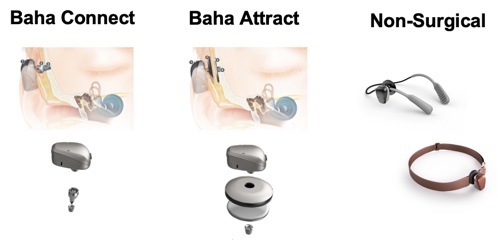
Figure 1. Baha systems.
The Baha Connect system is our Direct Connect system and has been around for more than 30 years. This system offers the best possible sound transmission with a direct connection to the osseointegrated implant through the skin (there is a snap that the sound processor attaches to). Some years ago, we introduced the Baha Attract system. This is an under-the-skin system based on the same implant structure, but instead of having a through-the-skin attachment point, there is a magnet under the skin. The sound processor attaches to the external magnet to hold it in place and provide a vehicle to receive the transmission through the skin. Finally, we offer non-surgical options. The softband is a good option for pediatric patients and patients younger than the age of five. More recently, we've introduced the Baha SoundArc under the non-surgical category. The SoundArc is a unique device that is a more comfortable and cosmetically pleasing option. This option is excellent for older children who are not yet ready for surgery, those who are doing a trial of the device, and adults who may not be suitable for surgery. Cochlear provides the broadest range of options for your patients with these three options.
Achieving the Best Outcomes for Patients
While Baha has been enormously successful as a treatment option, it is often deployed in a unilateral treatment paradigm. Even patients with bilateral, conductive, or mixed losses will often only receive one device. It is a well-established evidence-based fact that patents are much better off when we're able to treat both ears. However, in a 2017 EuroTrak study they found that bilateral hearing aid fittings made up 70% of their patient sample, while cochlear implants only comprised about 16% of their group, and those with bone conduction constituted only 6% of their sample (EuroTrak, 2017). These figures are similar in the United States.
Why isn’t this bilateral statistic higher? This is the issue we will explore today. We will discuss some of the clinical benefits of treating conductive and mixed hearing loss bilaterally, and then we'll move on to some practical candidacy selection tips and fitting recommendations.
Clinical Benefits of Bilateral Fitting
First, we are going to discuss the clinical benefits of Bilateral Baha systems. To that end, I'd like to begin by showing you a brief video of a patient named Anne. She is an excellent example of a patient who greatly benefits from a bilateral solution. Let's hear about her experience.

VIDEO TRANSCRIPTION: I'm Anne, and I'm a bilateral Baha implant recipient. I've gone through a lot in my life with my hearing; my journey has taken from my first surgery at three years old to my last implant done in 2009. I was born with nonfunctional eardrum in the right ear and fused stapes in both ears. I've had five surgeries. My first one at three, then the next one is nine, 12, 18, and then when I was 30. Every surgery, we're just so hopeful that something would come of it. And every time, it's just such a disappointment. I've tried hearing aids in the past. They helped, but not enough. I thought this is what I'd live with for the rest of my life. I heard about Bahas. And the more I read about it, the more intrigued I was, but I still had hesitation. What if it doesn't work this time? Will it make me feel even worse? Then I realized this is the only time we have. What do I have to lose? Once they attached, it was just amazing. All the different little sounds that I had never heard before. I came out of the cocoon basically. It wasn't that I was antisocial before, but I just kept the social setting very small. Now it's like more people the merrier. It's so much fun just talking to people whereas I limited myself so much before. Once I started hearing so much better, my family life actually did improve a lot. My professional life has improved with the implant. My self-confidence has increased dramatically, so I'm not afraid to speak up in meetings now. Once I have the sound processor attached, I just felt so much in love with it that when I went to a follow-up appointment, my surgeon said, "So, have you thought about doing the other side?" And I said, "Yes, when can we do it?" The procedure is actually very easy. You're in and out within a day and back to work within a couple of days. So many people don't realize what an asset it is to be able to hear with both ears. When you hear out of one ear, people call you, if they're standing on the wrong side of you, it's harder to hear. What's funny is people still ask, "Oh, am I walking on the right side?" No, it doesn't matter anymore. I've gone through life with a lot of challenges, and I've overcome them because that's my nature. I'm happier. I'm out more. I'm active more. I'm enjoying other people more. My philosophy on life is to enjoy it to the fullest, and the Baha 5 provides that.
Clinical Evidence
Everything we do today is driven by evidence-based practice, especially from the standpoint of cost justification to third-party payers, as well as being able to use the information for counseling patients. According to the clinical evidence, there are four main benefits to bilateral implantation.
- Improved ability to localize sound
- Improved hearing in noise
- Improvement in audibility
- Improved patient satisfaction
Improved ability to localize sounds. In a study conducted by Arjan Bosman and his colleagues in the Netherlands in 2016, they demonstrated that the vast majority of bilateral recipients are able to localize sounds to within 30 degrees, much better than chance level (Figure 2). For reference, individuals with normal hearing in both ears at the 95% confidence limit will be able to localize to an accuracy of about 11 degrees. It's easy to see that even with the improvement, we're not quite getting back to normal but the improvement does represent both low frequency and high-frequency improvement in accuracy of localization. In this particular study, the graph shows that they used the 500 Hz signal and a 2000 Hz signal to show how the binaural phenomenon improves things. They also looked at masking level differences and speech in noise, revealing that patients with bilateral Baha fittings were able to demonstrate true binaural hearing capacities, in many cases (Bosman et al., 2016). I think that's the ground rule for setting the discussion as we consider this for patients that we encounter in our daily clinical practice.
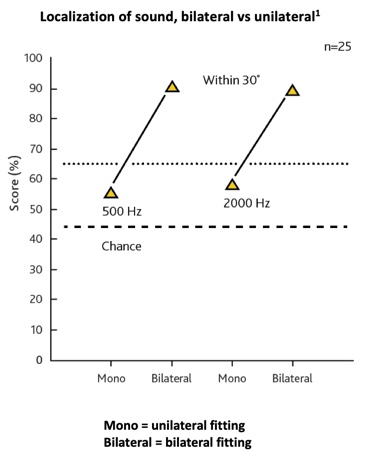
Figure 2. Localization of sound: bilateral vs. unilateral.
Improved hearing in noise. The other salient feature about a two-ear approach is that we generally see improvement in hearing in noise. There is a comprehensive list of several studies and articles cited in your handout that support the evidence for this talk today. In terms of bilateral advantages, we see up to a 3.1 dB of improved signal to noise ratio with bilateral Baha. In other words, there can be significantly more noise in the environment and the recipient can still understand speech. This helps the patient tremendously in their daily life, as background noise is one of the most common complaints from people with hearing impairment. We know that bilateral fittings of hearing aids can lead to an improved hearing in background noise, and bilateral Baha is no different (Jansen et al., 2012; Bosman et al., 2001; Priwin et al., 2004).
Improvement in audibility. Bilateral Baha improves audibility. There is a summation effect that occurs, which is essentially binaural redundancy. When sound hits two ears instead of one, there is a summation of these sounds in the brain, which means that the sound will seem louder when listening with two ears. If we think about this in terms of thresholds, the person's threshold will be lower when they are listening with two ears. In other words, they can simply hear better. There are several studies with bilateral Baha sound processors where SRT was measured in the unilateral vs. bilateral condition. Because of the summation effect, there is up to a 5.4 dB improvement in the SRT, simply from having two ears instead of one. This leads to improved dynamic range for the patient and speech perception in quiet. All of these benefits, in turn, lead to higher patient satisfaction (Jansen et al., 2012; Bosman et al., 2001; Hamann et al., 1991; Priwin et al., 2004).
Improved patient satisfaction. There are several studies to support the fact that patients experience increased life satisfaction when fitted bilaterally. One study, in particular, was out of Birmingham University in the UK in 2002. These researchers looked specifically at the patient’s perspective of a second bone conduction implant. They found that 9 out of 10 patients reported an increase in quality of life when fitted bilaterally (Dutt et al., 2002). Several other studies have shown similar improvements in quality of life and patient-reported benefit. We often hear this from patients. Even when the speech perception benefits may be small, patients overwhelmingly report an increase in the feeling of balance and improved satisfaction, often more for the second than the first (Ho et al., 2009; Arunachalam et al., 2001; McLarnon et al., 2004; Gillett et al., 2006).
Consensus Meeting 2018
While the clinical evidence for bilateral fitting is certainly compelling, it is still common in clinical practice for audiologists and surgeons to consider only one device. In May 2018, a panel of leading experts in the field of bone conduction convened a consensus on the benefits of bilateral fitting of bone conduction devices. The outcome of these discussions has been summarized in a white paper which is in your handouts today. In short, the clinical findings that we discussed previously were confirmed by this group. They recommended considering a bilateral fitting for adults with symmetric bone conduction. Their recommendation was even stronger for children, noting that bilateral fittings can allow children to potentially use all the auditory cues available to them and develop binaural processing at the central level. Their recommendation was strong that all children with bilateral loss who were within indications should be fit with bilateral Baha.
In summary, for the right patient, the published clinical evidence clearly suggests that there is a benefit to bilateral implantation for Baha. A two ear approach in bone conduction leads to improvements in the patient's ability to localize sound and hear in noise. It also suggests that a bilateral solution can improve audibility and lead to greater patient satisfaction. The audiologist is a pivotal individual in this process. As you're counseling patients who are potential candidates for implantation, you can discuss their options. Not everyone is necessarily going to a candidate, but we want to consider all options for these patients. It's important that we have good clinical evidence because patients today tend to be more inquisitive about their healthcare. They're going to be asking those questions. Hopefully, the resources that we provide for you today will help in terms of creating a better knowledge base for you for your counseling of these patients as you see them.
Choosing Candidates for Bilateral Baha Systems
That leads us to our next topic of conversation: choosing candidates for bilateral Baha. In terms of the indications for Baha candidacy, it is likely we will be spending most of our time dealing with conductive and mixed conductive hearing losses. However, although it is outside the scope of this presentation, we also want to acknowledge the indication for single-sided deafness (SSD). SSD is a unique problem, but it's useful for learners to know that that is also an option.
Single-Sided Deafness
Figure 3 shows a typical audiogram of someone who has perfectly normal hearing in their right hear and nonfunctional hearing in the left ear.

Figure 3. Audiogram of someone with SSD.
The FDA guidelines for implantation in someone with SSD are as follows:
- ≥ 5 years of age for a surgical solution
- Normal Hearing in the contralateral ear (defined as PTA Air Conduction thresholds equal to or better than 20 dB at 0.5, 1, 2 & 3 kHz). There is no specific level of impairment required for the nonfunctional ear other than it is not able to provide meaningful input from a typical amplification scenario, especially acoustic amplification.
- Functions by the transcranial routing of the signal. We are offering a contralateral offsite signal that gets transmitted through the bone conduction.
Again, we wanted to briefly discuss SSD candidacy because the majority of this presentation will be focused on conductive and mixed hearing loss, which often occur in a binaural, or two-eared scenario.
Conductive and Mixed Hearing Loss
With regard to conductive and mixed hearing losses, the FDA sets forth the following candidacy criteria for implantations:
- ≥ 5 years of age for a surgical solution (younger than this they would use a Softband or SoundArc)
- ≤ 65 dB HL Bone Conduction pure tone average (PTA)
- PTA of 0.5, 1, 2 & 3 kHz
- To consider a bilateral fitting, the FDA recommends the bone conduction thresholds in both ears be symmetrical, defined as less than 10 dB difference on average (0.5, 1, 2 & 3 kHz) or less than 15 dB at any one individual frequency
With regard to that last criteria, a person who has undergone implantation is now receiving a signal that's stimulated in the skull and creating a pathway through the bones and the skull to the cochlea. It's important to recognize that the mixed conductive bilateral scenario needs to be considered from the perspective of bone conduction profile and symmetry.
Bilateral Baha System Candidacy
Many of our patients with mixed or conductive hearing loss could benefit from bilateral hearing. The audiological indications are that the bone conduction thresholds are symmetrical, defined as 10 dB difference on average (.5, 1, 2 & 3kHz) or less than 15 dB at individual frequencies. This can be confusing sometimes, but essentially, the bone conduction should be approximately symmetrical between the ears. This is logical when you think about the common otological causes of mixed and conductive hearing loss in children and adults, many of which are bilateral. In adults, we often see bilateral chronic otitis media, or other conditions leading to a persistent air-bone gap. In children, some common conditions include bilateral microtia/atresia, ear canal stenosis or Treacher-Collins syndrome. All of these can be bilateral issues needing bilateral treatment.
Candidacy Evaluation
When we start talking about candidacy for evaluation, preoperative testing can be used to predict the post-operative benefit. This is probably one of the most important things that I like to emphasize when I talk about the Baha product line. Baha is a unique option in the implantable hearing world because we can demonstrate how the device is going to impact the patient's hearing loss before they commit to a surgical procedure. Figure 4 shows some vehicles that allow you to do that.

Figure 4. Devices used for preoperative testing.
On the left side of Figure 4 is the Baha test rod which allows for connection of the sound processor to a Lucite rod that can be held in place against the skull for a brief demonstration. All of our Baha products are shipped with this test rod. We also encourage recipients of the Baha treatment to use this to demonstrate to a normal hearing interested third party how this works to further the awareness of this treatment. Clinicians can use it as a quick way to demonstrate the benefits of bone conduction hearing. In the middle of Figure 4 is the SoundArc, and on the right is the Softband. These two devices are great vehicles for pre-operative testing and demonstrating with these patients to be able to give them a top-notch experience with the device.
Again, your decision about what to do is determined by what's best for the patient. A quick demo gives the patient some immediate feedback about how this treatment can impact their hearing impairment. If you can take the time to do a more formalized evaluation, using the Softband or the SoundArc are invaluable in conducting aided, pre-imposed treatment testing to demonstrate the efficacy and abilities of Baha. Finally, if you're so inclined and if it is dictated by your patient care and your counseling, a patient could take this device home and wear it on a trial basis to gain experience with the device. This makes it very unique in the implantable world. It's something that we try to encourage people to consider.
Steps for Evaluation
In terms of evaluation, we recommend that you fit the sound processor to the patient with either the SoundArc or Softband, using the Baha fitting software and the audiometric data that you collect from the patient as part of your diagnostic evaluation. The demo test rod is not an especially great tool to use when you're trying to evaluate this in a sound booth, because it has to be held physically in place, and that's sometimes hard to do. That's why SoundArc is a good tool to use. It's comfortable and it looks good and patients are comfortable with it in that test environment.
Next, we recommend performing objective testing with and without Baha to compare the patient's functional hearing in both scenarios. That achieves two things. First, it provides the patient with a real-life demonstration of how this is going to work. At the same time, the clinician can get an idea about the magnitude of improvement that might be expected if the patient does elect to go forward with treatment, either as a surgical option or non-surgical option. For patients with SSD, we recommend that you spatially separate speech in noise relative to where the Baha is placed. Keep in mind that in for an SSD patient, that sound processor is typically placed on the dead side and you want to point the noise in the good ear and allow speech to come through. That makes quite an impression on the patient and gives you the ability to do some speech in noise testing as well. It's also important to perform speech in noise testing with conductive and mixed losses, which we will discuss shortly.
In addition, it is important to evaluate subjective benefit. Informally, you can ask the patient questions, such as "How does it sound?" or "Can you hear me now?" Formally, a clinician can use questionnaires (e.g., the APHAB or the COSI) to determine the patient's perceived benefit. These assessments can set up some nice expectations, and the patient can then judge how they've done. Again, we need to counsel the patient, giving them the best experience and the most information so that they can make an informed decision about their treatment.
Tips for Bilateral Baha System Evaluation
If you are thinking about demonstrating for bilateral patients, there are a few things to keep in mind. First, when putting on a Softband or SoundArc, make sure that these devices do not touch the sound processor on the contralateral side (for patients who are already unilaterally implanted). Second, consider programming both sound processors so that they can be linked for Active Balanced Directionality, which we will discuss in more detail coming up in the presentation. Third, balance the loudness for the second side to the initial side. That gives the patient the ability to be able to hear and perform in the sound test environment that we recommended.
One consideration when you are setting up your speech testing is to compare results for the unilateral condition to the bilateral condition for speech in noise. For the best results, we would recommend speech directly in front and noise behind (i.e., speech delivered in front at 0 degrees azimuth and noise from behind at 180 degrees, about one meter apart). That gives you the optimum distance to provide a more real-world or ecologically valid way to evaluate speech in noise. You can then produce the target speech material through that front speaker and the jamming noise from behind. Using adaptive tests like Quick SIN or BKB-SIN or hearing in noise tests can help with that regard. It does produce more real-world situation when you turn one device on, and then you turn the second device on, and you turn one device off or both devices off. The patient clearly gets an experience that allows them to be able to hear the real benefits and it creates some confidence in your recommendations. Again, depending on your clinical situation and how your program is set up, you may offer a take-home trial. The take-home trial usually involves a fitting where the patient leaves the office and wears it for some pre-determined time in a real-world situation. That trial can sometimes be the deciding factor as to whether the patient chooses implantation or not.
Features in Baha Sound Processors to Support Bilateral Fitting
Next, we're going to review some new bilateral features in the Baha sound processors that can be enabled with our new fitting software.
Processor Portfolio
As shown in Figure 5, the Baha 5 sound processors are small, smart and powerful.
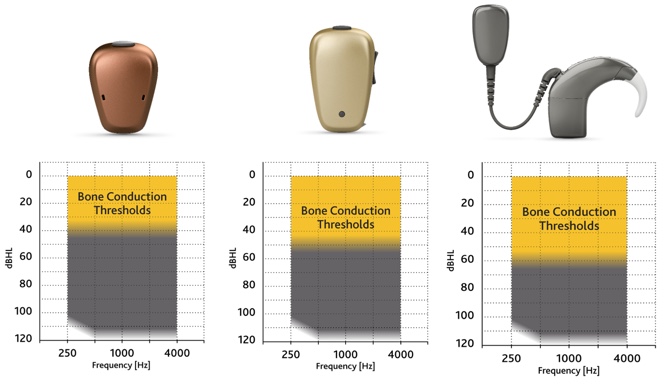
Figure 5. Baha 5 sound processors.
Beginning on the left of Figure 5, you can see that the fitting range for the Baha 5 sound processor is up to 45 dB average level. You can see that at about 45 dB, things start to blend out. If your bone conduction thresholds fall in the shaded area at the top of the audiogram, you can be confident that you're in the right ballpark.
The next processor in the middle of Figure 5 is the Baha 5 Power device, which gives us a little bit more headroom and a larger fitting range. It uses a larger battery, it has an LED onboard, and it fits up to a 55 dB hearing levels.
Finally, we round out the portfolio with the Baha 5 SuperPower on the far right of Figure 5. This is the most powerful ear-level head-worn processor in the bone conduction arena and will fit up to a 65 dB loss. It has a split design, which gives it the ability to provide its power, and multiple wearing configurations. Sometimes, this product is used in the severe mixed loss arena as you're approaching that 55-65 dB level. The SuperPower can work well for patients who need that. In worst case scenarios, the device can be fitted as a body-worn device off the ear, which then improves the wearer's ability to access gain. As you can see, the Baha portfolio is designed to provide a lot of choices, as one solution does not fit all.
BCDrive Transducer Technology
One of the things that make Baha technology unique is the powerful BCDrive Transducer (Figure 6). It was thoughtfully designed by our manufacturing facility in Sweden. Compared to traditional transducers, the BCDrive transducer provides less distortion, greater and more reliable longevity, and two-times greater efficiency by design.
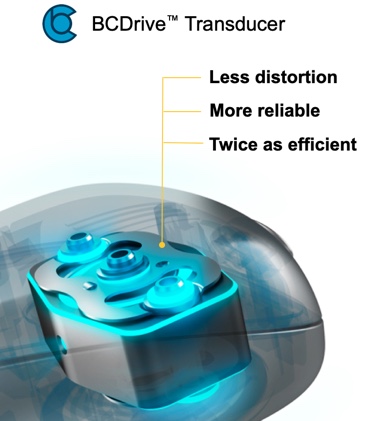
Figure 6. BCDrive Transducer.
The BCDrive Transducer is designed for clearer sound. Figure 7 shows a side-by-side comparison of the conventional transducer that has historically been used in bone-anchored devices vs. our Baha device. In looking at the fundamental components of the conventional transducer, it is a moving mass transducer. It has a spring and it has a counterweight. You'll notice that in this particular conventional transducer design, there is a single spring that separates the magnet which is moving against the force contact plate. The spring and magnet forces are asymmetrical, causing output force on only one side of the mechanism and this results in a vibrational signal. However, the output forces, especially as we get to the top of it, tend to round off and become a little bit more distorted with sound. This conventional transducer was the best thing that we had available at the time, but there were limits to what we could do from an efficiency perspective with that type of design.

Figure 7. Conventional transducer vs. BCDrive transducer.
In contrast, the BCDrive technology demonstrates that the actual transducer can not only be made in a smaller form factor but also become twice as efficient. The fundamental difference between our conventional transducer and our BCDrive transducer is that the new BCDrive transducer is a symmetrical transducer. The moving magnet is supported by two springs, instead of just the single spring that you see in the conventional, and force is produced on both sides of the mechanism. When we look at the output force of the device, we see a sharper sine wave representation (i.e., less distortion). Because of the case design and the way it's manufactured robotically at the factory creates a much more reliable long-term solution for bone conduction devices. In short, the BCDrive is the heart of what makes this Baha technology hum.
Active Balanced Directionality and Scene Classifier II
Moving on, let’s focus on those features of the Baha 5 family of sound processors which are useful for bilateral fittings. With Baha fitting software 5.4, Cochlear expands our unique technology in the Ardium Smart Platform to enable smart connectivity through automatic ear-to-ear exchange between a bilateral pair of Baha 5 sound processors. This has the effect of converting the entire listening environment into one complete soundscape, maximizing the potential of two sound processors working together. This is all possible with the Ardium chip and does not require a sound processor upgrade to access – just the update to the Baha Fitting Software.
Active Balanced Directionality is a feature that takes advantage of this ear-to-ear communication. Scene Classifier II is a part of the Active Balanced Directionality system. Active Balanced Directionality uses information from the Scene Classifier II to set the optimum directionality mode for each sound processor to give the bilateral user the best hearing experience in any given sound environment. Scene Classifier II automatically selects the best signal processing for each processor in any given situation, giving the best possible sound processing to patients in any given situation.
For example, in quiet environments, you want to maximize environmental awareness. Therefore, both sound processors are put in omnidirectional mode. In a scenario where speech is from the front and noise is from the sides, you want to maximize speech intelligibility in front of the user. Therefore, both sound processors are put in directional mode. For noisy environments in which speech is coming from multiple directions, you want to provide speech intelligibility from the front and environmental awareness around the user. Therefore, the sound processors are put in an asymmetric directional mode. In other words, one sound processor is set in directional mode, while the other processor is in omni-directional mode. Finally, in situations where there is a single talker from the side or behind in a noisy environment, the sound processors adapt their directionality to maximize the speech intelligibility.
In summary, the sound processors adapt to the situation and switch directionality mode as needed. All of this occurs seamlessly in the background with our Active Balanced Directionality feature enabled. In addition, this process works in harmony with the Scene Classifier II to provide the best possible scenario with an automatic ear-to-ear exchange.
When fitting the patient, you could either have two Baha 5 or two Baha 5 Power devices with this ear-to-ear exchange, or you can have a Baha 5 on one side and a Baha 5 Power on the other side and still be able to take advantage of this. Where you need to be careful is when you want to apply the SuperPower device, because of the fact that it's a very different architecture in terms of the chipset and the way it works. The ear-to-ear exchange cannot occur between a Baha 5 or a Baha 5 Power on one side and a SuperPower on the other. With that said, if you're fitting a Baha 5 SuperPower on both sides, you can get the ear-to-ear exchange which then helps to be able to provide these types of features.
Improved Speech Perception in Noise
While we know this type of technology helps those with hearing aids, we needed to verify that this would be the case for Baha recipients as well. Early technical and clinical testing was performed to validate the benefits of an asymmetrical vs. symmetrical directional approach.
In our validation study, the test subjects were normal-hearing listeners with a simulated conductive hearing loss. They were exposed to a complex listening situation with babble noise presented from the front while the speech was presented from behind. The use of normal hearing subjects with simulated conductive loss is definitely not ideal, but this gives us some early confidence that the benefits of this type of technology are similar to what is seen with hearing aids. This preliminary data along with what we know about how this technology works in hearing aids, gives us the confidence to recommend it for use in our patients.
When exposed to the challenging listening situation, the test subjects were able to correctly repeat more words when using the new Asymmetric Directionality Mode (68% vs. 45%). The actual improvement was 23 percentage points in correctly repeated words when going from comparing a symmetrical with an asymmetric directionality mode. These test results indicate that an Asymmetric Directionality Mode can be advantageous when being exposed to this listening situation and would be a useful directionality mode to add to the existing SmartSound iQ signal processing options.
(D1508053 Summary of clinical investigations of simulated ABD)
Bilateral Wireless Streaming
In addition to the ability of the sound processors to act as a pair in the soundscape, bilateral wireless streaming is possible and more seamless with the new updates. The Ardium Smart Platform is a unique technology enabling a direct-to-device connection to both ears. Baha 5 recipients have always had access to our true wireless accessories (i.e., the mini microphone, phone clip, and TV Streamer). These devices uniquely stream to the sound processor with no intermediary devices (e.g., a neck loop) necessary. Baha 5 sound processors are also made for iPhone, with direct streaming from any iOS device possible to both ears. Finally, the Baha 5 Smart App is available for both iPhone and Android devices, providing user control and information for most Smartphones. Bilateral control is now possible even if the patient has a Baha 5 on one side or a Baha 5 Power on the other.
What does this all mean for your patients? First, it allows them to listen on the phone in noisy situations. If the phone connects to both sides, the noise in the environment is bypassed, allowing for a better phone experience, whether the patient is using the iPhone directly or another type of phone through the Phone Clip. Hearing over distance is also easier. For example, a child in the classroom can use the Mini Microphone 2+ streaming to both ears to hear the teacher's voice over the background noise in the classroom. Or, an adult attending a conference can hear the speaker better through their iPhone mic. Perhaps most important is the ability to hear conversations better in noisy environments. The wireless Mini Microphone or the mic in your iPhone can stream directly to both ears, allowing better conversations in groups or noisy settings, such as restaurants.
Baha Fitting Software Enhancements
The last bilateral feature I'd like to mention are some enhancements to the software, allowing for easier bilateral programming. These enhancements include:
- Ability to enable or disable Active Bilateral Directionality as desired (as we recognize that one size does not fit all)
- Ability to fit a Baha 5 and Baha 5 Power as a bilateral pair
- Bilateral linking allows program changes in both ears at once
- Copy audiogram feature allows for quick entry of bilateral audiograms in stand-alone software
Fitting Considerations for Bilateral Baha Systems
Finally, let’s take a closer look at some of the fitting considerations for bilateral Baha and some of the software changes you can expect to see with Baha Fitting Software 5.4. The Baha 5.4 fitting software is the most current version of the software that supports all of these features discussed in the presentation today. If you have access to myCochlear Clinic, you can obtain a link to that software update. Or, your Cochlear representative can provide you with an emailed link. The installation instructions are easy and intuitive.
Bilateral Fitting Tips
We recommend the following tips for a bilateral fitting (Figure 8):

Figure 8. Baha fitting software 5.4 screenshot.
- Upon opening the fitting software, connect to both sound processors to begin programming. Remember, if you are going to demonstrate a bilateral sound processor to a unilateral recipient, connect both sound processors if time permits to enable the bilateral features and best possible demonstration experience.
- The link button at the top of the screen will allow you to keep the processors linked together during programming. This makes things faster since you only have to make changes once and it affects both sides. If you want to unlink and make changes to only one ear, this is possible at any point in the programming flow.
- Matching processors can be linked, or you can link a Baha 5 to a Baha 5 Power. At this time, it is not possible to link a Baha 5 Super Power to another type of processor (due to its unique chipset), but you can link two Baha 5 Super Powers if needed.
As shown in Figure 9, if you're familiar with the software, the BC Select feature identifies certain characteristics of the patient and applies program settings as needed. If the processors are linked, these selections will be applied to the defaults of both processors. For example, if you choose a child and the processors are linked, then the buttons will be disabled on both sound processors. You can choose adult vs. child, the type of connection (Attract vs. Connect), and other options. Of course, we still want to encourage you to measure your BC Direct or your NC2 audiometry separately for each ear. You don't need to plug the opposite ear, but this gives the software the maximum amount of information to build a fitting that's specific and unique to that particular patient's hearing profile.
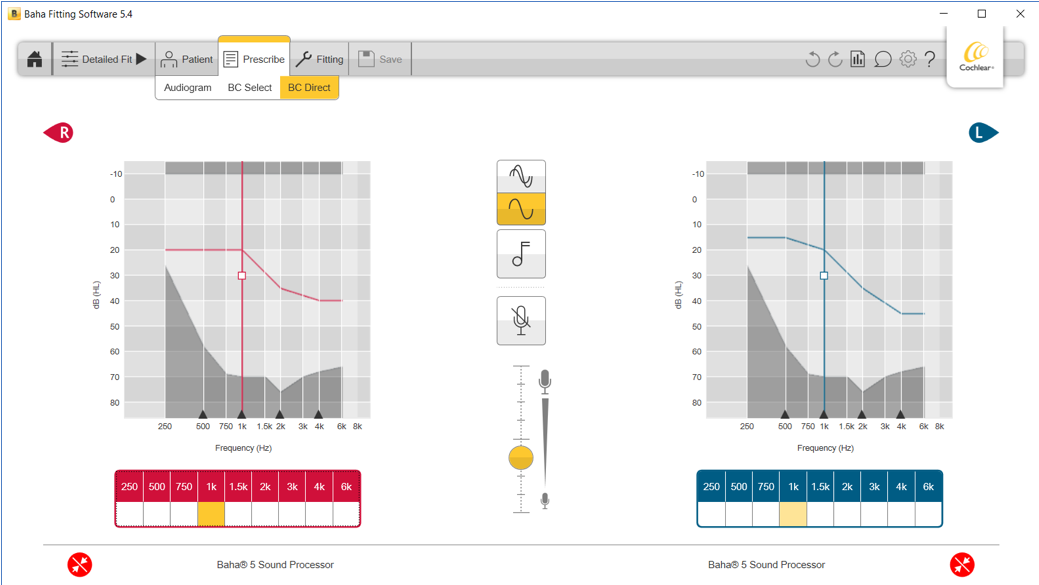
Figure 9. Fitting software: BC Direct and BC Select.
BC Direct is the next step in programming. This allows you to measure thresholds through the sound processors and it is a very important step in programming that should be completed for every patient. You can perform it separately for each ear, as shown in Figure 9.
As you move on to the program settings, you may find that you want to make changes separately to each ear. If so, you can click on the link button to “unlink” the processors and make changes independently (Figure 10). You also have the option of using the arrows to copy settings from one side to the other. This can be helpful if you are fitting a second side, as it allows you to quickly maintain the settings on both sides. Control Sync is another feature which is great for bilateral recipients. With Control Sync, if they change programs or volume on one side, the other side will be changed as well.

Figure 10. Screenshot of software: unlink processors and Control Sync function.
After you have successfully fitted the sound processors, there is the ability to link and register the devices on myCochlear Clinic (Figure 11). We want to encourage you at all costs to register these devices because it is in the best interest of your patient. Once the device is registered, we then know that a sound processor with a particular serial number is linked to a patient that you've worked with. When these patients call in for support, we can track them. This registration step is made easier by this connection with myCochlear Clinic. If you're not using it already, speak to your Cochlear representative because this is a useful tool to have at your disposal.
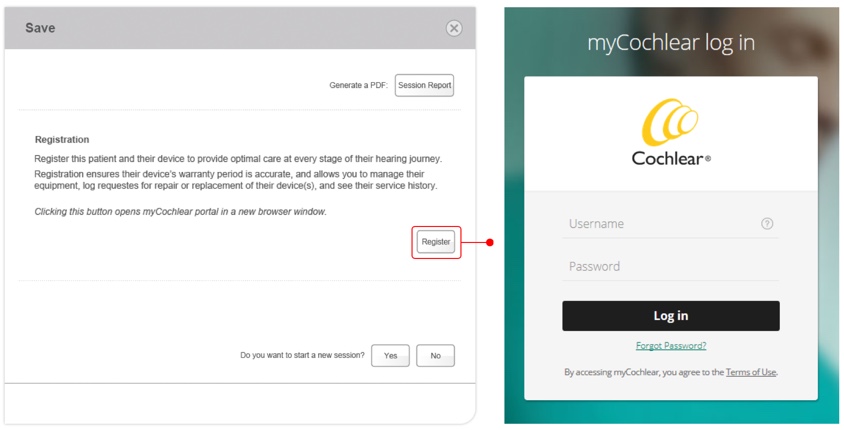
Figure 11. Register the device on myCochlear Clinic.
Summary and Conclusion
In summary, one of the main goals of this particular course is to reinforce the idea that two ears are better than one. This is not rocket science or a revelation to anyone in the audiology community. We've talked about how we've done it over the years with acoustic amplification and also in cochlear implantation. The right patients will benefit from these bone conduction solutions. The audiologist's ability to counsel and provide information becomes the important hinge pin to being able to give the patient the best information so that they can make a decision.
Another key point of this presentation is to highlight the unique features of Baha 5 sound processors that allow and support the use of bilateral fittings, when appropriate. Many times, patients will report benefit from a bilateral fitting but it can be difficult to quantify that benefit. Think back to the video that we viewed earlier. That particular patient eloquently described the difference that was made in her life experience with two Bahas. With the right patients, a bilateral bone conduction solution will be beneficial and improve outcomes.
Thank you for your participation today. I hope I’ve provided you with some information to help you identify which patients should be considered for a bilateral fitting. We are excited about our new fitting software and feel that the Baha 5 family of sound processors have several unique features that make bilateral fittings easy and straightforward and provide the best possible benefit to your patients. Please reach out to your local Cochlear representative if you have any questions about getting the new fitting software or using the new bilateral features. If you think of any additional questions, feel free to email me at gcire@cochlear.com.
Questions and Answers
How can you measure the bone conduction via the device without masking the other side, especially when there's a difference between ears?
Keep in mind that masking is important in clinical diagnostic evaluation because you're trying to maintain and understand your specific results. But when you're fitting a Baha device, there's no masking involved by the device on the opposite side. The idea is that you need to do unmasked bone conduction testing, and that's what the software addresses. This goes back to the concept of bilateral symmetry that we discussed earlier. If you have an asymmetric bone conduction profile (where you have normal bone conduction thresholds in the right ear and a fairly large or maximum conductive hearing loss in the left ear, with a bone conduction average threshold of 35, for example), when you apply the signal to both ears, that better hearing cochlea is going to respond. That's what the perception is going to be about. It's not that they're not getting any benefit from that poor bone conduction. It's just that it's a psychophysical phenomenon based on bone conduction that lateralizes the better-hearing cochlea. That makes the need to do masking in bone conduction irrelevant. What we're trying to do is select patients that have very symmetrical bone conduction profiles, and then to test those devices individually so that small differences get teased out and the software can make the best possible decisions for that patient.
So even though sound crosses over, there's still benefit to fitting both sides?
Yes, absolutely, there is a benefit. It's just very difficult to measure. A lot of people who have studied bilateral hearing via bone conduction don't fully understand the impact that it has on the brain's ability to process interaural level and timing differences. When you're dealing in the acoustic hearing aid environment with two separate levels of hearing, you're able to drive those signals differently through the ear canal and through the middle ear through the cochlea, and you can have very different profiles. As such, you can actually equalize or normalize. But when you're doing bone conduction transduction through that Baha device, if one ear is clearly better than the other ear, the perception is that they're only hearing out of that one ear, and their ability to localize is lacking. When you look back at the Bosman study and some of the other studies, in terms of bilateral testing, patients with these asymmetrical bone conduction profiles, when tested with Baha in directional localization skills and spatial hearing skills don't get the benefit. Offering binaural Bahas is about being able to provide that spatial hearing and also that summation effect and the improvement.
References
Agterberg MJ, Hol MK, Cremers CW, Mylanus EA, van Opstal J, Snik AF. Conductive hearing loss and bone conduction devices: restored binaural hearing? Adv Otorhinolaryngol. 2011;71:84-91.
Arunachalam PS, Kilby D, Meikle D, Davison T, Johnson IJ. Bone-anchored Hearing Aid quality of life assessed by Glasgow Benefit Inventory. Laryngoscope 2001;111:1260-3.
Bosman AJ, Snik AF, van der Pouw CT, Mylanus EA, Cremers CW. Audiometric evaluation of bilateral fitted bone anchored hearing aids. Audiology. 2001;40:158-167.
Dun CA, Agterberg MJ, Cremers CW, Hol MK, Snik AF. Bilateral Bone Conduction Devices: Improved Hearing Ability in Children With Bilateral Conductive Hearing Loss. Ear Hear. 2013;34(6):806-8.
Dutt SN, McDermott A, Burrell SP, Cooper HR, Reid AP, Proops DW. Patient satisfaction with bilateral bone-anchored hearing aids: the Birmingham experience. J Laryngol Otol Suppl. 2002;116:37-46.
Gillett D, Fairley JW, Chandrashaker TS, Bean A, Gonzalez J. Bone-anchored hearing aids: results of the first eight years of a programme in a district general hospital, assessed by the Glasgow Benefit Inventory. J Laryngol Otol 2006;120:537-42
Hamann C, Manach Y, Roulleau P. Bone-anchored hearing aid. Results of bilateral applications [in French]. Rev Laryngol Otol Rhinol (Bord). 1991;112:297-300.
Ho EC, Monksfield P, Egan E, Reid A, Proops D. Bilateral bone anchored hearing aid: impact on quality of life measured with the Glasgow Benefit Inventory. Otol Neurotol. 2009;30:891-896.
Jansen RM, Hong P, Chadha NK. Bilateral bone-anchored hearing aids for bilateral permanent conductive hearing loss: a systematic review. Otolaryngol Head Neck Surg. 2012;147(3):412-22.
McLarnon CM, Davison T, Johnson IJ. Bone-anchored Hearing Aid: comparison of benefit by patient subgroups. Laryngoscope 2004;114:942-4.
Priwin C, Stenfelt S, Granstrom G, Tjellstrom A, Hakansson B. Bilateral bone-anchored hearing aids (BAHAs): an audiometric evaluation. Laryngoscope. 2004;114:77-84.
Citation
Cire, G. (2019). Trends in bone conduction: considerations for treating both ears. AudiologyOnline, Article 25238. Retrieved from https://www.audiologyonline.com


